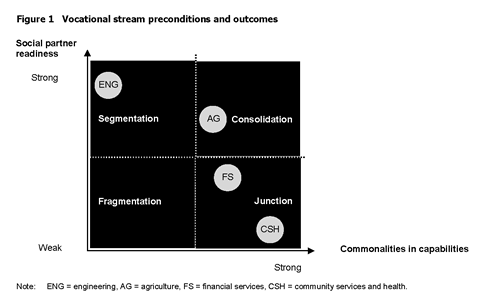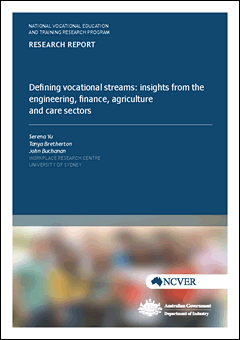Description
The authors identify the potential for vocational streams – a set of linked occupations with related skills in a broad field of practice – in the areas of agriculture, financial services, engineering and healthcare/community services. To further explore this idea, they interview a range of stakeholders on the usefulness of a vocational stream framework for the labour market. This report identifies two preconditions for vocational streams as well as describes scenarios of how these preconditions play out in industry. This work is part of the three-year research program 'Vocations: the link between post compulsory education and the labour market'.
Summary
About the research
This report is part of a wider three-year program of research, Vocations: the link between post-compulsory education and the labour market, which is investigating the educational and occupational paths that people take, and how their study relates to their work. This report builds on previous research by the authors, which identified a vocational stream as a set of linked occupations with related skills within a broad field of practice. They argue that vocational streams can play a role in increasing the capacity of the workforce and in helping to address skill shortages.
As part of the second year of the program, the authors interviewed a variety of stakeholders, including industry, employee, education, government and occupation groups, to validate the usefulness of a vocational stream framework for the labour market. The authors identify the preconditions for vocational streams to occur and how these preconditions can play out in industry.
Key messages
- Two preconditions are identified for realising enhanced, more adaptive workforces through vocational streams. Links in terms of underpinning skills and knowledge, or ‘commonalities in capability’, is the first precondition that supports a vocational model of workforce development. The second precondition is the potential for commitment and cooperation across stakeholders, or social partners, on resolving issues such as skills shortages.
-
These two preconditions operate interdependently. Ultimately, stakeholder engagement, collaboration and the market environment within a specific sector are all key influences in shaping vocational outcomes. The preconditions react together in producing three possible outcomes:
- a lack of common capabilities, where specialisation occurs early in an occupation or field of study, thereby creating segmentation in the labour market and limiting mobility across occupations and weakening the impact of partner collaboration
- an outcome characterised by linkages between occupations and an absence of institutional collaboration; for example, in the healthcare sector, where a lack of cooperation has hampered the development of more generalist roles
-
a scenario in which there are both occupational linkages, in terms of underpinning capabilities, and a high degree of social partner readiness, evidenced by a high degree of cross-occupational mobility. For example, in agriculture this outcome is characterised by compromise, the pursuit of cooperative solutions and a commitment of resources to address workforce challenges.
Rod Camm
Managing Director, NCVER
Executive summary
This report has been prepared as part of the National Centre for Vocational Education Research (NCVER) Consortium Research Program: Vocations: the link between post-compulsory education and the labour market. The research seeks to understand the presence of vocational pathways in core sectors of the Australian labour market — agriculture, financial services, engineering, and healthcare and community services. There are three strands in the project. Strand 1 focuses on improving outcomes from entry-level vocational education and training (VET), particularly VET in Schools. Strand 2 focuses on the role of educational institutions in improving pathways within and between vocational education and training and higher education. Strand 3 focuses on understanding the nature of vocations and their potential improvement. This is a report on Strand 3’s research in 2012. In the first phase of research in 2011, we defined a ‘vocational stream’ as a set of occupations within a broad field of practice, linked by the knowledge, skills and capabilities required to work within a broadly defined vocation that combines educational and broad occupational progression.
In this phase of research, Strand 3 researchers conducted in-depth stakeholder interviews across the four sectoral case studies, asking the questions:
- How, if at all, are occupations related by underpinning practices and concepts? Can we thus identify occupations comprising a vocational stream?
- Who are the social partners that oversee these linked (or otherwise) occupations and how do they support/inhibit the development of capability within and between these occupations?
- What could emerge from current arrangements?
We argue that vocational streams are readily identified across the four sectors. That is, in the three sectors facing skills shortages (engineering, healthcare and agriculture), linkages between occupations were identified as a means for increasing workforce capacity. Even in financial services, where there was no sense of crisis, mobility between occupations was regarded as commonplace. We argue that these linkages, defined in terms of the underpinning skills and knowledge, are the first essential precondition for supporting a vocational model of workforce development. These commonalities in capabilities not only support improved utilisation of the workforce, but underpin a more adaptable individual, someone able to flourish under changing conditions within a broad area of practice. Capabilities link individuals, education and work by identifying the resources — social and economic — that individuals need to develop as autonomous and innovative workers within a broad range of occupations (Wheelahan & Moodie 2011).
These commonalities took on a number of dimensions across the four sectors. In healthcare, the scope of practice could be considered to be care (linking care workers, nursing assistants, enrolled nurses, registered nurses, and across areas such as mental health, aged care and disability care), or allied health (including occupational therapy, physiotherapy, podiatry etc.). Health workers share common capabilities both horizontally across traditional occupational boundaries as well as vertically, into higher levels of responsibility. In financial services, in the absence of any real systemic or sectoral approach to workforce development, mobility in a broad area of practice took on an organisational dimension. This was characterised by strong recruitment processes, horizontal and vertical career paths, and training in strong internal labour markets. This organisational dimension is also emerging within the corporatisation of the agricultural sector. However, the most dominant theme in the agricultural industries was one of regional capabilities. This has already emerged strongly in areas where commonalities in local skills and knowledge extend across agricultural, local government and mining operations. In engineering, highly structured education and training paths in both the trades and professions tend to emphasise specialisation relatively early, so there is a greater focus on linking paraprofessional/technical occupations to the professional engineer. Importantly, across all four sectors, intermediate occupations were seen both as destination roles within a vocational stream as well as stepping stones and vital links between lower and higher skilled roles. These roles included paraprofessionals in engineering, agricultural technicians, financial advisors and brokers, and enrolled nurses and allied health assistants.
Commonalities in capabilities is one of two enabling conditions for realising greater and more adaptive workforce capacity around a vocational stream framework. The second is that of social partner readiness, or the potential for institutional commitment and cooperation on workforce challenges. This involves mobilising and consolidating a community of trust associated with a common objective; for example, skills shortages, and involves not only compromise and pursuit of cooperative solutions, but also a commitment of resources. These social partners may include industry, employee, community, educational and government groups. Social partner readiness recognises two key tenets of social capital theory: first that durable forms of social capital must exist (including trustworthiness, networks and institutions), and second that the linkage between social capital and collective action is trust (Ostrom & Ahn 2003). In each of the four sectors, we observed varying levels of social capital, ranging from tacit networks in financial services, to a complex web of formal and informal institutions in healthcare. The importance of trust was also highlighted across the case studies and ranged from high levels of contestation in healthcare, to consensus among employer, union, and educational groups in engineering.
In agriculture, engineering, and healthcare, the catalyst has unequivocally been long-standing skills shortages. The challenges are well documented, and in these three sectors institutional collaboration has gained momentum to varying degrees. In agriculture, regional projects have aligned industry, local government, employer, community and educational stakeholders across industries (such as mining and agriculture) in a bid to manage the otherwise chaotic flows of seasonal labour and regional emigration. In engineering, national solutions to skills shortages have been endorsed by a wide range of social partners (Australian National Engineering Taskforce [ANET] 2012) and gained support at a parliamentary enquiry. In financial services, employers, universities, TAFE (technical and further education) institutes and industry groups have yet to be mobilised around workforce issues, as the industry continues to contract. And in healthcare, the substantial complexities associated with public health risk, role clarity, occupational standards, boundaries and regulation, and different learning models present significant barriers to leveraging the clear commonalities in the capabilities across occupations.
These two preconditions — commonalities in capabilities and social partner readiness — generate three key outcome scenarios, depending on how the preconditions are met:
- Segmentation is characterised by a lack of commonalities in underpinning knowledge and skill, as in the engineering sector, where specialisation tends to occur early, and there is limited mobility across occupational boundaries. Segmentation is therefore likely to persist, despite a cooperative set of social partners.
- Junction is defined by a hitherto absence of institutional cooperation, despite recognised commonalities in capabilities between occupations. Two scenarios exist within this model: first, in the healthcare/community services sector, institutional arrangements are characterised by groups which defend entrenched institutional boundaries; second, in financial services, there is an absence of explicit stakeholder engagement with skills issues, with workforce development flourishing implicitly across the sector.
- Consolidation is characterised by both recognised commonalities in capabilities, linking occupations in a scope of practice, as well as a higher level of social partner readiness, as witnessed by greater levels of stakeholder engagement and a commitment of resources, as in agriculture.
These three key outcomes and the preconditions which generate them are shown graphically in figure 1.
Figure 1 Vocational stream preconditions and outcomes

We argue that the identification and promotion of both commonalities in capabilities and greater institutional cooperation have the capacity to assist with current severe workforce challenges and also to support a workforce of more adaptable, capable individuals. In each sector, we identified strong examples of initiatives aiming for collaborative solutions, models or ideas which reach across educational, industry and government divides to give individuals access to educational and occupational pathways. In the third and final phase of research in 2013, we will endeavour to consolidate the architecture of these models and explore how their successes could (or could not) be deployed in different settings.
Download
Related items
Focusing on four vocational streams – financial services, primary industry, healthcare/community ser… Show more
This report explores the movements that workers make in the workforce and whether there are any comm… Show more
